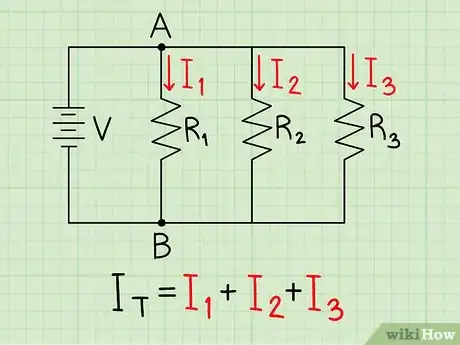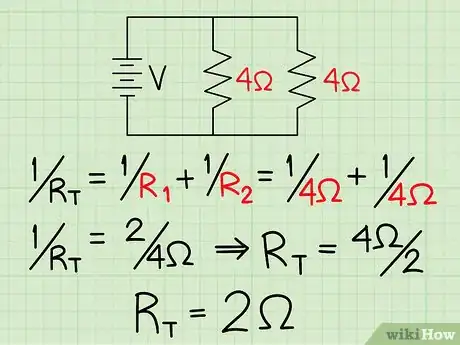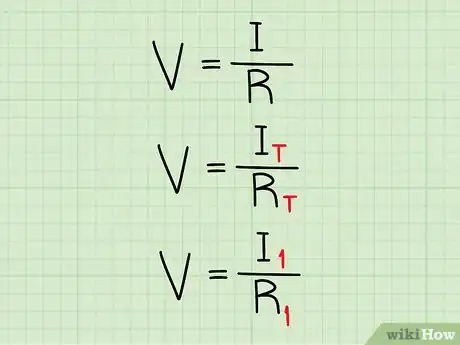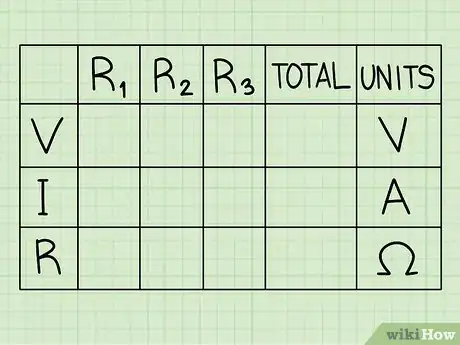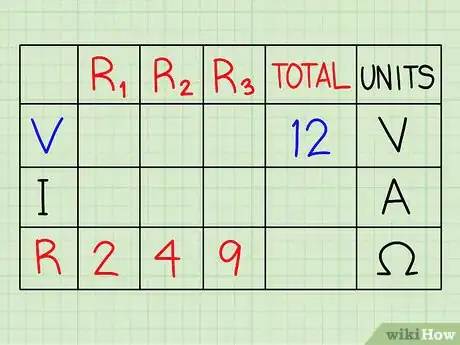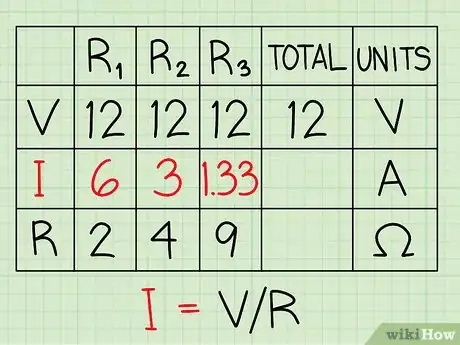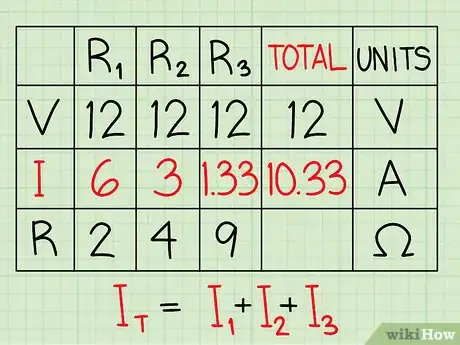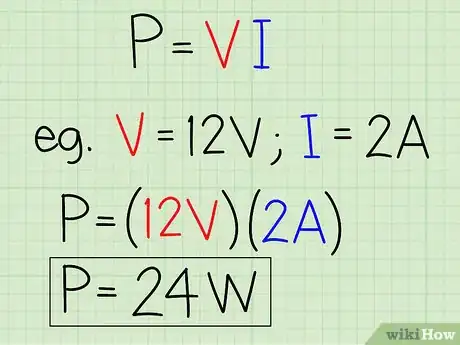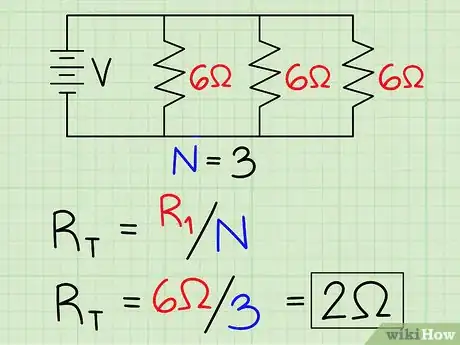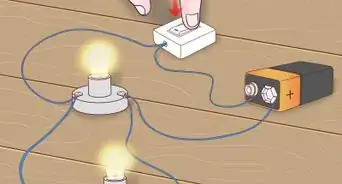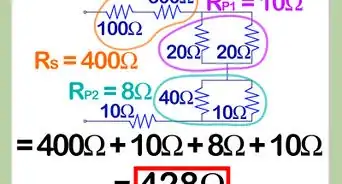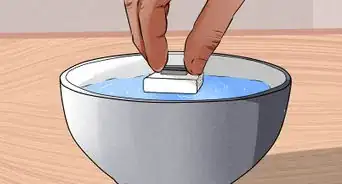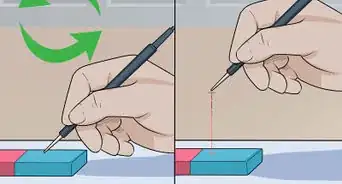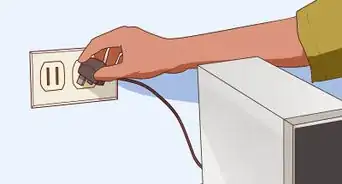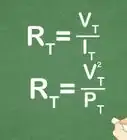wikiHow is a “wiki,” similar to Wikipedia, which means that many of our articles are co-written by multiple authors. To create this article, 35 people, some anonymous, worked to edit and improve it over time.
There are 9 references cited in this article, which can be found at the bottom of the page.
wikiHow marks an article as reader-approved once it receives enough positive feedback. In this case, several readers have written to tell us that this article was helpful to them, earning it our reader-approved status.
This article has been viewed 552,436 times.
Learn more...
Solving parallel circuits is an easy process once you know the basic formulas and principles. When two or more resistors are connected side by side the current can "choose" it's path (in much the same way as cars tend to change lanes and drive alongside one another when a one-lane road splits into two parallel lanes).[1] After reading these steps you should be able to find the voltage, current and resistance between two or more resistors in parallel.
Cheat Sheet
- Total resistance RT for resistors in parallel: 1/RT = 1/R1 + 1/R2 + 1/R3 + ...
- Voltage is always the same across branches: VT = V1 = V2 = V3 = ...
- Total current IT = I1 + I2 + I3 + ...
- Ohm's Law: V = IR
Steps
Introduction to Parallel Circuits
-
1Identify parallel circuits. A parallel circuit has two or more branches that all lead from point A to point B. A single stream of electrons divides to flow through multiple branches, then merge back into one stream on the other side. Most problems involving parallel circuits will ask you to identify the total voltage, resistance, or current across the circuit (point A to point B).[2]
- Components "connected in parallel" are each located on a separate branch.
-
2Understand current and resistance in parallel circuits. Imagine a freeway with multiple lanes, and toll booths in each lane slowing down traffic. Building a new lane gives the cars another path to take, so it will always speed up traffic even though you're adding a new toll booth as well. Similarly, adding a new branch to a parallel circuit gives current an additional path to take. No matter how much resistance that new branch has, the total resistance of the circuit will decrease, and total current of the circuit will increase.[3]Advertisement
-
3Sum currents in each branch to find total current. If you know the current in each branch, just add them together to find the total current. This is the amount of current flowing in the circuit after all the branches come together. In formulaic terms: IT = I1 + I2 + I3 + ...[4]
-
4Solve for total resistance. To find total resistance RT across the circuit, solve for it in the equation 1/RT = 1/R1 + 1/R2 + 1/R3 + ... where each R on the right-hand side represents the resistance on one branch of the circuit.[5]
- For example, a circuit has two resistors in parallel, each with 4Ω resistance. 1/RT = 1/4Ω + 1/4Ω → 1/RT = 1/2Ω → RT = 2Ω. In other words, two branches of equal resistance are exactly twice as easy to get through as one branch alone.
- If one branch has no resistance (0Ω), all the current goes through that branch. The total resistance is 0.[6]
-
5Remember what voltage describes. Voltage is the difference in electric potential between two points. Since you're comparing two points, not examining a path of movement, the voltage will remain the same no matter which branch you're looking at.[7] VT = V1 = V2 = V3 = ...
-
6Find missing values with Ohm's Law. Ohm's Law describes the relation between voltage V, current I, and resistance R: V = IR. If you know two of these values, use this formula to solve for the third.[8]
- Make sure every value refers to the same portion of the circuit. You may use Ohm's Law to examine the total circuit (V = ITRT) or a single branch (V = I1R1).
Example Circuit
-
1Make a chart to keep track of your work. If you have a parallel circuit with several unknown values, a chart will help you organize your information.[9] Here's an example chart for a circuit with three parallel branches. Note that branches are often referred to as R followed by a subscript number.
R1 R2 R3 Total Units V volts
I amperes
R ohms
-
2Fill in all the information given by the problem. For our example, we'll use a circuit powered by a 12 volt battery. The circuit has three parallel branches, with resistances 2Ω, 4Ω, and 9Ω. Add this information to your chart:
R1 R2 R3 Total Units V 12
volts
I amperes
R 2
4
9
ohms
-
3Copy the voltage value to each branch. Remember that the voltage across the whole circuit equals the voltage across each branch of a parallel circuit.
R1 R2 R3 Total Units V 12
12
12
12
volts
I amperes
R 2
4
9
ohms
-
4Use Ohm's Law to find the current in each branch. Each column in your chart includes voltage, current, and resistance. This means you can always solve for a missing value as long as you have the other two values in the same column. If you need a reminder, Ohm's Law is V = IR. The missing value is current in our example, so we can rearrange this as I = V/R.[10]
R1 R2 R3 Total Units V 12
12
12
12
volts
I 12/2 = 6
12/4 = 3
12/9 = ~1.33
amperes
R 2
4
9
ohms
-
5Solve for total current. This is an easy value to find, since the total current equals the sum of the currents in each branch.[11]
R1 R2 R3 Total Units V 12
12
12
12
volts
I 6
3
1.33
6 + 3 + 1.33 = 10.33
amperes
R 2
4
9
ohms
-
6Solve for total resistance. You can find this in two different ways. You can use the resistance row to calculate it using the formula 1/RT = 1/R1 + 1/R2 + 1/R3. However, it's often easier to solve for it using Ohm's Law and the total V and I values. When solving for resistance, rearrange Ohm's Law as R = V/I
R1 R2 R3 Total Units V 12
12
12
12
volts
I 6
3
1.33
10.33
amperes
R 2
4
9
12 / 10.33 = ~1.17
ohms
Additional Calculations
-
1Calculate power. As in any circuit, power P = IV. If you've solved for power along each of the branches, the total power PT equals the sum of all branch power values (P1 + P2 + P3 + ...).[12]
-
2Find total resistance for a two-branch circuit. If there are exactly two resistors in parallel, you can simplify the equation to the "product over sum" equation:
- RT = R1R2 / (R1 + R2)
-
3Find total resistance when all resistors are identical. If every resistor in parallel has the same resistance value, the equation becomes much simpler. RT = R1 / N, where N is the number of resistors.[13]
- For example, two identical resistors in parallel provides ½ the total resistance of one resistor alone. Eight identical resistors provide ⅛ of the total resistance.
-
4Calculate branch currents without voltage. This equation, called Kirchhoff's current divider rule, lets you solve for individual branch currents even if you don't know the circuit voltage.[14] You'll need to know the resistance of each branch, and the total current f the circuit:
- Two resistors in parallel: I1 = ITR2 / (R1 + R2)
- More than two resistors in parallel: To solve for I1, find the combined resistance of all resistors besides R1. Remember to use the formula for resistors in parallel. Now use the equation about, replacing R2 with your answer.
Community Q&A
-
QuestionThree resistors A, B and C are connected in parallel and take a total of 7.9 ampere. Resistor A takes 2.5 ampere and has a resistance of 48 ohms. The current through B is twice as much as that of C. How can I calculate the currents of resistors B and C?
 Community AnswerSubtract 2.5 from 7.9, and divide the result by 3. The result is the current of C. Multiply this by 2 to find the current of B.
Community AnswerSubtract 2.5 from 7.9, and divide the result by 3. The result is the current of C. Multiply this by 2 to find the current of B. -
QuestionHow can I find the total power in the current voltage?
 Community AnswerFind the total power in any circuit: pt=p1+p2+p3+,,,+pn. In terms of voltage and current, by using this formula: p=vi (or) p=i*i*r (or)p=v*v*r.
Community AnswerFind the total power in any circuit: pt=p1+p2+p3+,,,+pn. In terms of voltage and current, by using this formula: p=vi (or) p=i*i*r (or)p=v*v*r. -
QuestionWhat happens in a parallel circuit?
 Community AnswerIn a parallel circuit, current gets divided among the parallel branches in a manner so that the product of current and the resistance of each branch becomes the same. The sum of the current in each branch is equal to the total current of the circuit.
Community AnswerIn a parallel circuit, current gets divided among the parallel branches in a manner so that the product of current and the resistance of each branch becomes the same. The sum of the current in each branch is equal to the total current of the circuit.
References
- ↑ https://www.swtc.edu/ag_power/electrical/lecture/parallel_circuits.htm
- ↑ https://www.physicsclassroom.com/class/circuits/Lesson-4/Parallel-Circuits
- ↑ https://www.physicsclassroom.com/class/circuits/Lesson-4/Parallel-Circuits
- ↑ https://www.physicsclassroom.com/class/circuits/Lesson-4/Parallel-Circuits
- ↑ https://pressbooks.bccampus.ca/basicelectricity/chapter/ground/
- ↑ http://www.tpub.com/neets/book1/chapter3/1-34.htm
- ↑ https://pressbooks.bccampus.ca/basicelectricity/chapter/ground/
- ↑ https://workforce.libretexts.org/Bookshelves/Electronics_Technology/Book%3A_Electric_Circuits_I_-_Direct_Current_(Kuphaldt)/05%3A_Series_And_Parallel_Circuits/5.03%3A_Simple_Parallel_Circuits
- ↑ https://www.allaboutcircuits.com/textbook/direct-current/chpt-5/simple-parallel-circuits/
- ↑ https://workforce.libretexts.org/Bookshelves/Electronics_Technology/Book%3A_Electric_Circuits_I_-_Direct_Current_(Kuphaldt)/05%3A_Series_And_Parallel_Circuits/5.03%3A_Simple_Parallel_Circuits
- ↑ https://workforce.libretexts.org/Bookshelves/Electronics_Technology/Book%3A_Electric_Circuits_I_-_Direct_Current_(Kuphaldt)/05%3A_Series_And_Parallel_Circuits/5.03%3A_Simple_Parallel_Circuits
- ↑ https://www.allaboutcircuits.com/textbook/direct-current/chpt-5/power-calculations/
- ↑ http://physics.bu.edu/py106/notes/Circuits.html
- ↑ https://www.wilsonware.com/electronics/kirchhoff.htm
About This Article
To solve parallel circuits, you'll need to know that parallel circuits have two or more branches that all lead from point A to point B. If you want to solve for total current, use the equation IT = I1 + I2 + I3 where IT is the total current, and I1 through I3 are the currents in each branch. If you want to solve for total resistance, simply use the equation 1/RT = 1/R1 + 1/R2 + 1/R3, where "R" equals the right side. The voltage of a circuit is the same on all sides and you can use Ohm's law, or V = IR, to find missing values. To see an examples of solving these equations, scroll down.


